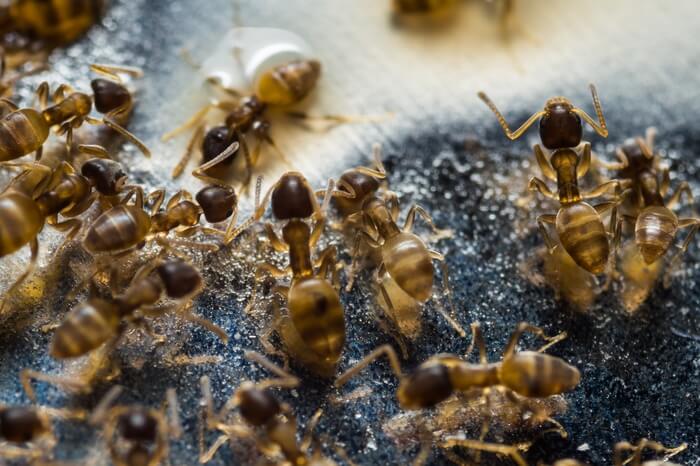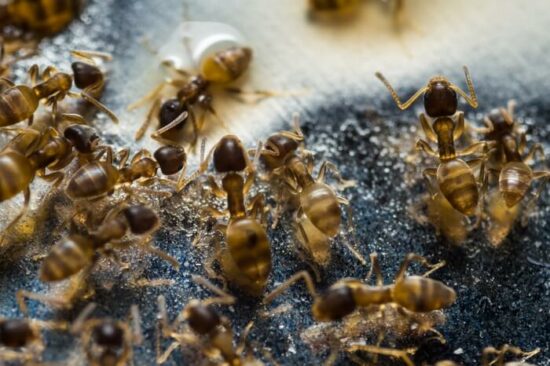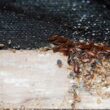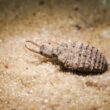Getting rid of grease ants doesn’t have to be complex. While these insects are quite tough and adaptable, it’s possible to kill them and reclaim you home with the right approach.
This guide will teach you how to get rid of grease ants, plus some helpful information about these pests that will make your job easier.
Table of contents
What Are Grease Ants?
Grease ants are common household pests that are found all across the United States. They reside in all corners of the country and are known for being quite resilient (in even rough weather conditions).
Usually, you can find them living under rocks, around foundations, or within decaying wood. They can also build colonies in bare soil.
Of course, these pests can also make their way into your home.
Compared to other home-invading ant species, grease ants are pretty easy to identify. They’re noticeably smaller than other ants, measuring about 1.5 to 2.2 millimeters long. The physical appearance of these insects is unique as well.
- Kills common household ants including acrobat, crazy, ghost, little black, odorous house, pavement, and other sweet-eating ants
- As worker ants discover the bait, they share it with the rest of the colony to eliminate them all
- You should see a significant decrease in the number of ants visiting the bait stations within just a few days
- Place stations near areas where you’ve seen ant activity
First off, the body is smooth and shiny. There are no ridges on the head or spines on the thorax. The ants are sporting two nodes at the intersection between the thorax and abdomen.
The abdomen features a small stinger, which the ant can use for defense. However, it doesn’t do much to puncture human skin. This species isn’t known to bite or sting at all, resulting in more passive behavior than anything else.
Quick Tip: If you take a magnifying glass to these ants, you’ll notice small compound eyes and antennae with two segments on the head.
One of the most prominent identifying features is the ant’s color. Instead of the dark brown or black coloration you typically see in household ants, these guys are pale brown (as you’ll see in some of the pictures we’ve included). Some even border on light yellow.
What They’re Attracted To
As you can guess from their name, grease ants gravitate towards greasy substances. They love to snack on natural oils, animal fat, and dairy products.
These ants actively seek oil-filled foods. Whether that’s in the form of human-made food or decaying animal meat, they don’t discriminate!
While greasy foods are their main draw, thief ants don’t have a problem snacking on anything that’s available. They’ll eat sugary sweets, seeds, protein-based foods, and much more.
Quick Tip: These ants will even consume dead insects and larvae.
Interestingly enough, grease ants have a penchant for thievery. They like to establish colonies near the homes of other ant species. Some groups will even invade more extensive underground networks and live discretely among other ants!
That quirky behavior is all about stealing resources! The ants will take food and pupae from other species to consume at their discretion. For this reason, they’ve earned themselves the nickname of “thief ant!”
Ways They Get Into Your Home
Grease ants enter homes in the same way that most other species do. They find small cracks and crevices to move through. But unlike larger species, grease ants can fit into the most discrete access points imaginable!
Usually, these ants are drawn into your home because of food and warmer temperatures. The pests do fine living in the rough conditions of the open outdoors, but your home presents far better prospects!
The environment is more predictable, and food sources are readily available. Why not make a move?

Thief ants typically send out worker ants to search for food. These ants are trail-setting insects. That means that they use pheromones to establish trails for others to follow.
When scouts find a way inside your home and discover some food, it’s not long until others show up. The scent trails are invisible to the human eye. But, they can go long distances to guide ants back and forth between food and the colony.
Grease ants often meander their way into your home through small cracks around doors or windows. Some may even wiggle their way through voids in the foundation or small openings in exterior walls. Remember, the smallest ants are only 1.5 millimeters long, so getting into tight spots is not an issue whatsoever.
Once inside, grease ants can go pretty much anywhere. Usually, you’ll find their scent trails along baseboards, in cabinets, under countertops, and around any other small opening. It doesn’t take long for a large infestation to develop that you’ll need to get rid of!
How To Get Rid Of Grease Ants
Many people who want to learn how to get rid of grease ants get intimidated by this tough species. They assume that the process is going to be a serious challenge!
And they’re partially correct.
Thanks to their tiny footprint and habit of getting into the tiniest of hiding places, killing grease ants is a tall order. While these pests aren’t known to bite or sting, they can easily carry disease and bring unwanted pathogens into your home. That makes getting rid of them extremely important.
Fortunately, this is actually quite straightforward once you know what to do.
1. Locate Nests & Pheromone Trails
First things first, you need to observe these insects a bit!
Finding their nest and scent trails will dramatically increase your chances of getting rid of grease ants. Sure, you could just place bait traps and apply insecticides willy nilly. But to have the most impact, you have to target the ants directly and hit them where it hurts!
The best way to do that is to know where they hide out.
Take a moment to watch the ants. If you’re patient enough, you should be able to identify an established scent trail. Follow it back to the nest, and you can find that elusive nesting spot.
Quick Tip: Inspect the area and learn as much about the ants as you can. How big is the colony? Where are they getting their food? Are they even grease ants?
The answers to those questions can guide your efforts moving forward.
2. Place Bait
Next, you’ll need to get some bait and place it in a spot the grease ants can access.
- Kills common household ants including acrobat, crazy, ghost, little black, odorous house, pavement, and other sweet-eating ants
- As worker ants discover the bait, they share it with the rest of the colony to eliminate them all
- You should see a significant decrease in the number of ants visiting the bait stations within just a few days
- Place stations near areas where you’ve seen ant activity
The best way to get rid of grease ants is to use poisoned bait food. Ant sprays and contact killers have their place in your pest-fighting arsenal. However, they only take care of the insects you can see.
Unless you attack the entire colony, those ants will keep coming back! Thief ants are quick to proliferate. They’re a polygynous species, which means that they can have up to eight queens in a single colony. With each queen laying upwards of 387 eggs a day, it won’t take long for the infestation to get out of hand.
Luckily, bait traps can take care of the entire ant population.
You have a couple of common options here. You can use either borax or commercial bait products.
Borax is a natural compound that slowly disrupts the digestive system of ants that eat it. The process is slow, but that’s what makes it so effective. Ants will not feel the effects of the poison until several hours after pigging out on the bait.
By then, workers have already brought it into the nest and dispersed it to the entire colony!
Commercial baits work in a similar way. You can get liquid chemical bait or premade traps. The premade products are great for those who want a more hands-off approach to the extermination process. However, liquid chemicals offer more versatility.
Whether you kill ants with borax or a commercial poison, the one part of the equation you can’t forget is bait food.
Borax and chemicals alone aren’t going to attract these insects. If you want to kill great ants, they have to eat the bait. That means you must make it as appetizing as possible. To do that, simply mix the substance with a viable food ingredient.
We already know that grease ants prefer greasy foods, so use that knowledge to your advantage!
To make borax bait, combine equal parts borax powder with edible oil. You can use cooking oil, lard, peanut butter, or even leftover bacon grease!
Mix the solution up until the borax is fully incorporated. Then, put it into a shallow dish.
For commercial baits and chemical ant-killers, you can use the same kind of oil to attract grease ants. Mix a single drop of the oil to around five drops of the poison. Once you make enough of the bait, plop it onto some wax paper or cardboard for easy access.
Quick Tip: No matter what kind of bait you use, the application is always the same. The goal is to put the bait as close to known scent trails and nests as possible. You want to make the bait easily accessible, so place several around critical areas to maximize success.
3. Use Insecticide Spray Outside
It can take several weeks to kill larger colonies inside your home. Bait traps are a waiting game, so be patient and give the poison all the time it needs to make its way through the nest.
In the meantime, you can focus your attention outside.
Grease ants can live in many places around your yard. This is why so many homeowners want to get rid of ants in their lawn. You might find them in some rotted wooden fencing, under slabs of concrete, or in large mounds in loose soil.
Whatever the case may be, you’ll have to use different extermination techniques to get rid of grease ants that are outdoors. Borax or commercial bait products aren’t very effective on grease ants you find outside. That means you’ll need to utilize insecticide sprays.
Insecticides work on contact. They interrupt the ant’s nervous system, plug up breathing holes, and cause near-instantaneous death.
Like we mentioned earlier, insecticide sprays only work on the ants you can see. Because they work so fast, there’s no way for sprayed ants to spread it to the colony.
For this reason, it’s going to take repeated applications to get the job done.
Follow scent trails back to nests and hiding places. Then, douse them in the chemical spray! Soak the nest and pay close attention to any nooks and crannies nearby.
Repeat the application as stated in the product instructions.
Quick Tip: Like all chemical-based treatments, exercise caution and limit the product’s spread to only where it’s needed. Insecticides can harm beneficial insects, kill plants, and pose safety risks for children and pets.
Be extra careful to ensure that you don’t experience any unwanted side effects when killing grease ants.
How To Get Rid Of Grease Ants Naturally
Not ready to whip out the harsh chemicals just yet? We don’t blame you!
There’s no denying that chemicals are effective at getting rid of grease ants and any other household pest. However, the potential risks might make it out of the question for some. Fortunately, there are some natural alternatives.
If you’re looking for an eco-friendly form of pest control and an all-natural alternative to insecticide sprays, you have a few different options.
The first and most cost-efficient is a mixture of vinegar and water. Most insects detest vinegar. Not only is it super intense and off-putting to pests, but the acidic pH level can deteriorate protective exoskeletons.
Mix equal parts white vinegar and water in a spray bottle. Give it a good shake and start spraying it liberally! You can apply the vinegar solution directly to nests and trails. It works well as a long-lasting deterrent, too.
Another option is soapy water. Soap is a surfactant that dissolves the waxy protective layer on an ant’s exoskeleton. Not only that, but it breaks the surface tension and allows water to flow into breathing holes.
A liberal spray of soapy water will work well to kill grease ants on the spot. Combine one part dishwashing soap with two parts water. For even better results, use warm water!
Another natural way to get rid of grease ants is to use a peppermint oil spray. Like vinegar, peppermint is an aromatic substance that ants hate. It’s unappealing to ants and can interfere with the pheromones that these pests use for coordination. Use enough of the spray, and it’ll quickly drown the buggers, too.
Add about 20 drops of peppermint essential oil to two cups of water. Shake everything up to combine it and go to town! If you don’t have access to peppermint oil, any aromatic essential oil should provide similar results.
Quick Tip: Do you prefer a store-bought product? Believe it or not, natural insecticides do exist on a commercial scale. Instead of harsh chemicals, they use pyrethrins. Pyrethrins are natural pesticides that come from chrysanthemum flowers. It’s toxic to ants, fleas, and several other pests.
Best of all, pyrethrin-based sprays break down quickly and have a relatively low toxicity level to humans. While not completely safe, they’re much better than the chemical-based alternatives!
Last but not least, we have diatomaceous earth. You can find diatomaceous earth in your local gardening center. It comes in powder form that’s easy and safe to handle.
Diatomaceous earth is made of the fossilized remains of diatoms. The particles are super-fine and shape ants. On contact, the powder creates tiny injuries that eventually force the grease ant to bleed out and dehydrate.
The all-natural powder is affordable, easy to use, and versatile enough to use inside or outside your home.
Preventing Them From Coming Back
Don’t make the mistake of thinking that you’re done with grease ants for good after you’ve gotten rid of them. These critters are resilient and can return quickly. To prevent that from happening, you’ll need to take several steps that make your home unappealing to these pests.
Start by sealing up any cracks or voids the grease ants may have used as an access point. All infestations start outside. Closing up all of the ant’s entryways will ensure that they can’t set up a colony in your home ever again.
Quick Tip: Use some caulk to seal cracks around the doors, windows, and foundation. Make sure to address all of the voids you saw earlier with previous infestations.
Once that’s taken care of, reconsider the condition you leave your kitchen in every night.
Avoid leaving food out in the open. Put everything in an airtight container that ants can’t make their way through. Then, take out the garbage to remove any attractive smells that call to the ants.
Don’t forget to clean up all the surfaces in your kitchen that could have food remnants on them. That includes countertops, kitchen sinks, and floors. Pay attention to areas that get exposure to grease, too.
For example, oil splashes from the food you fried up earlier could become a goldmine to a hungry ant colony. Wipe everything down with proper disinfectants or oil-cutting solutions. You can even use the vinegar or soap sprays we went over earlier to remove scent trails and other smells.
If you want to be extra cautious, consider using some deterrents. Store-bought deterrent sprays can create an invisible barrier around your home. The same goes for all-natural spray solutions and aromatic plants.
Apply sprays liberally and plant several herbs around your home. A combination of prevention tactics can work wonders to keep your home ant-free!
Wrapping Up
Getting rid of grease ants isn’t as hard as it seems. With the right knowledge and a bit of dedication, you’ll be able to kill these pests and keep them from coming back.
If you have questions about these insects or need help identifying them, all you have to do is send over a message. We’ll get back to you as soon as we can!



